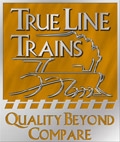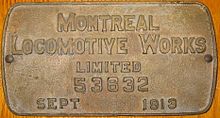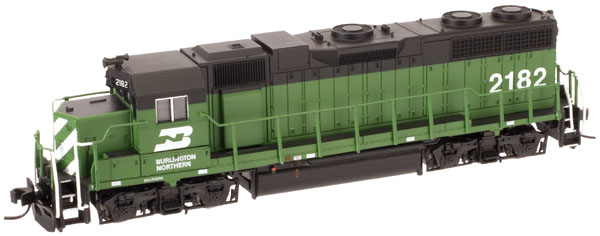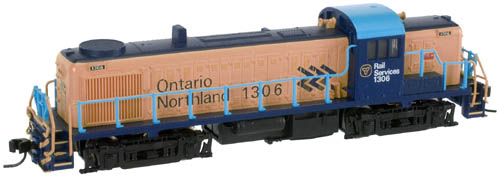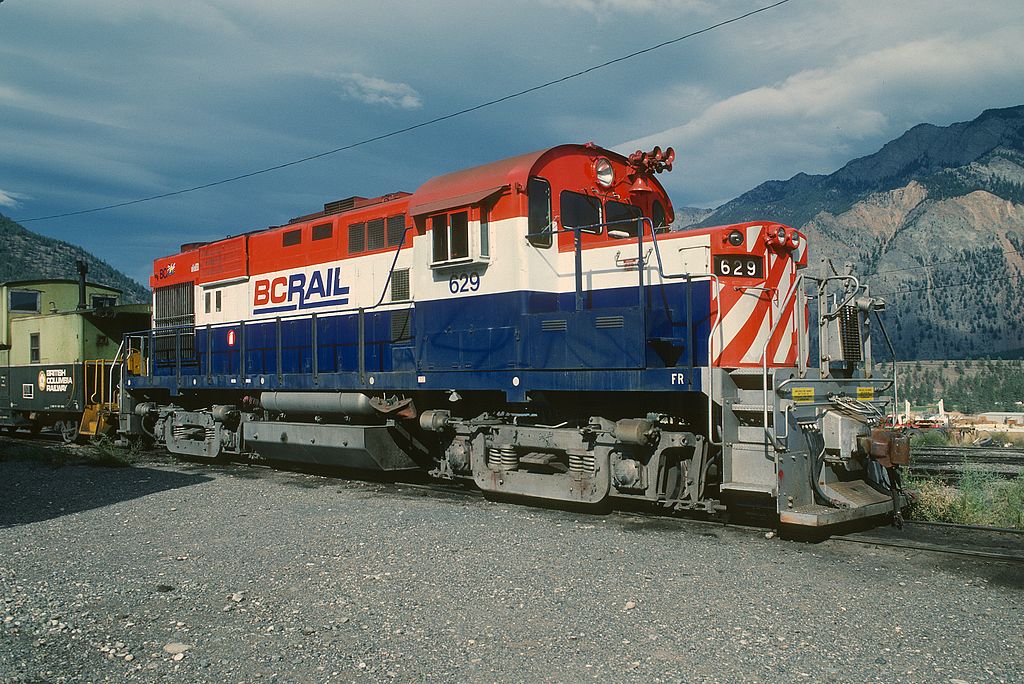Model Information: These locomotives are basically the Chinese-made Atlas RS-11 model (just with a couple of minor variations in shell detailing). The mechanism sports all the features one normally associates with "modern" Atlas diesels - IE, split-frame / all-metal chassis, 5-pole / skew-wound "scale speed" motor, dual flywheels, low-friction drive, bi-directional "white" LED lighting, all-wheel drive and pickup (no traction tires), blackened / low-profile wheels, shell-mounted Accumate couplers, all-plastic gearing, etc. The chassis is fully DCC-Ready.
DCC Information: Accepts the same drop-in decoders as Atlas Alco RS-11:
- Digitrax DN163A0: 1 Amp N Scale Mobile Decoder for Atlas N-Scale GP40-2, U25B, SD35, Trainmaster, B23-7 and others
- TCS AMD4 (Installation for Atlas RS-11)
- NCE N12A0: Plug and play decoder for N-Scale Atlas GP40-2, U25B, U23B, B23-7, 30-7, 36-7, GP38, SD25, TRAINMASTER, etc.
- MRC 1812: N-Scale Sound Decoder for most Atlas short/medium 4-axle locos (selection of 4 prime movers - not prototypical for this model however)
- Digitrax DN163A0: 1 Amp N Scale Mobile Decoder for Atlas N-Scale GP40-2, U25B, SD35, Trainmaster, B23-7 and others
- TCS AMD4 (Installation for Atlas RS-11)
- NCE N12A0: Plug and play decoder for N-Scale Atlas GP40-2, U25B, U23B, B23-7, 30-7, 36-7, GP38, SD25, TRAINMASTER, etc.
- MRC 1812: N-Scale Sound Decoder for most Atlas short/medium 4-axle locos (selection of 4 prime movers - not prototypical for this model however)
Prototype History: The MLW RS-18 was an 1,800 hp (1,340 kW) diesel-electric locomotive built by Montreal Locomotive Works between December 1956 and August 1968. It replaced the RS-10 in MLW's catalogue, and production totalled 351 locomotives, to eight customers. It was the Canadian version of the ALCO RS-11, although MLW did manufacture the RS-11 for Ferrocarriles Nacionales de México.
Canadian National Railway, by far the largest buyer of the RS-18, continued to specify the long hood as the front. By contrast, while all of Canadian Pacific Railway's RS-10s were long-hood-forward, all of their RS-18s were short-hood forward. All of CN and CP's locomotives were delivered with full-height short hoods, as were the first four Pacific Great Eastern Railway, and first Roberval and Saguenay Railway unit. The remaining production was for locomotives with a low short-hood, giving the train crew much better forward vision.
From Wikipedia
Canadian National Railway, by far the largest buyer of the RS-18, continued to specify the long hood as the front. By contrast, while all of Canadian Pacific Railway's RS-10s were long-hood-forward, all of their RS-18s were short-hood forward. All of CN and CP's locomotives were delivered with full-height short hoods, as were the first four Pacific Great Eastern Railway, and first Roberval and Saguenay Railway unit. The remaining production was for locomotives with a low short-hood, giving the train crew much better forward vision.
From Wikipedia
Road Name History: The Canadian National Railway Company (reporting mark CN) is a Canadian Class I railway headquartered in Montreal, Quebec that serves Canada and the Midwestern and Southern United States. CN's slogan is "North America's Railroad". CN is a public company with 24,000 employees. It had a market capitalization of 32 billion CAD in 2011. CN was government-owned, having been a Canadian Crown corporation from its founding to its privatization in 1995. Bill Gates was, in 2011, the largest single shareholder of CN stock.
CN is the largest railway in Canada, in terms of both revenue and the physical size of its rail network, and is currently Canada's only transcontinental railway company, spanning Canada from the Atlantic coast in Nova Scotia to the Pacific coast in British Columbia. Its range once reached across the island of Newfoundland until 1988, when the Newfoundland Railway was abandoned.
Following CN's purchase of Illinois Central (IC) and a number of smaller US railways, it also has extensive trackage in the central United States along the Mississippi River valley from the Great Lakes to the Gulf of Mexico. Today, CN owns about 20,400 route miles (32,831 km) of track in 8 provinces (the only two not served by CN are Newfoundland & Labrador and Prince Edward Island), as well as a 70-mile (113 km) stretch of track (see Mackenzie Northern Railway) into the Northwest Territories to Hay River on the southern shore of Great Slave Lake; it is the northernmost rail line anywhere within the North American Rail Network, as far north as Anchorage, Alaska (although the Alaska Railroad goes further north than this, it is isolated from the rest of the rail network).
The railway was referred to as the Canadian National Railways (CNR) between 1918 and 1960, and as Canadian National/Canadien National (CN) from 1960 to the present.
Read more on Wikipedia.
CN is the largest railway in Canada, in terms of both revenue and the physical size of its rail network, and is currently Canada's only transcontinental railway company, spanning Canada from the Atlantic coast in Nova Scotia to the Pacific coast in British Columbia. Its range once reached across the island of Newfoundland until 1988, when the Newfoundland Railway was abandoned.
Following CN's purchase of Illinois Central (IC) and a number of smaller US railways, it also has extensive trackage in the central United States along the Mississippi River valley from the Great Lakes to the Gulf of Mexico. Today, CN owns about 20,400 route miles (32,831 km) of track in 8 provinces (the only two not served by CN are Newfoundland & Labrador and Prince Edward Island), as well as a 70-mile (113 km) stretch of track (see Mackenzie Northern Railway) into the Northwest Territories to Hay River on the southern shore of Great Slave Lake; it is the northernmost rail line anywhere within the North American Rail Network, as far north as Anchorage, Alaska (although the Alaska Railroad goes further north than this, it is isolated from the rest of the rail network).
The railway was referred to as the Canadian National Railways (CNR) between 1918 and 1960, and as Canadian National/Canadien National (CN) from 1960 to the present.
Read more on Wikipedia.
Brand/Importer Information: The Canadian distributor for Life-Like products, Hobbycraft Canada, saw a missing segment in market for Canadian model prototypes, and started producing a few Canadian models that were later, with a few modifications, offered in the US market with US roadnames. At a later point Hobbycraft Canada was renamed Life-Like Canada.
When Life-Like was acquired by Walthers, Life-Like Canada was spun off and renamed True Line Trains. They are known as manufacturers of prototypically accurate HO- and N-scale locomotives and freight cars.
When Life-Like was acquired by Walthers, Life-Like Canada was spun off and renamed True Line Trains. They are known as manufacturers of prototypically accurate HO- and N-scale locomotives and freight cars.
Item created by: Alain LM on 2016-07-27 06:07:14. Last edited by gdm on 2018-05-21 09:57:00
If you see errors or missing data in this entry, please feel free to log in and edit it. Anyone with a Gmail account can log in instantly.
If you see errors or missing data in this entry, please feel free to log in and edit it. Anyone with a Gmail account can log in instantly.



